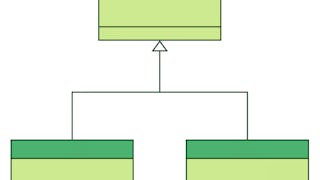An applied analysis and design class that addresses the use of object-oriented techniques. Topics include domain modeling, use cases, architectural design and modeling notations. Students apply techniques in analysis and design projects. Focus is on key object-oriented elements and concepts.

Enjoy unlimited growth with a year of Coursera Plus for $199 (regularly $399). Save now.

Object-Oriented Analysis and Design: Foundations & Concepts
This course is part of Object-Oriented Analysis & Design Specialization

Instructor: Bruce Montgomery, PhD, PMP
1,708 already enrolled
Included with
Recommended experience
What you'll learn
Apply industry-standard languages such as Java to object-oriented software designs.
Design object-oriented solutions with structural, behavioral, and composite graphical UML diagrams
Design test cases appropriate to object-oriented applications using JUnit.
Skills you'll gain
Details to know

Add to your LinkedIn profile
5 assignments
See how employees at top companies are mastering in-demand skills

Build your subject-matter expertise
- Learn new concepts from industry experts
- Gain a foundational understanding of a subject or tool
- Develop job-relevant skills with hands-on projects
- Earn a shareable career certificate

There are 5 modules in this course
An introduction to the benefits and challenges in applying Object-Oriented Analysis and Design (OOAD). The overall specialization and the instructor are introduced here. Then the challenges of developing software to support changing requirements are reviewed, and the Object-Oriented (OO) paradigm is presented as a possible approach to better analysis and design. Lectures examine how the OO approach differs from other programming paradigms and how it can provide helpful perspectives in conceptual, specification, and implementation design stages. Students should consider their background in Java and begin appropriate tutorial study at a level needed to allow use of the language in course projects (suggested resources are provided).
What's included
8 videos4 readings2 assignments2 discussion prompts
The module provides a review of core OO foundational concepts, including abstraction, encapsulation, modularity, polymorphism, delegation, inheritance, identity, and more. Key OO terminology for discussing aspects of class and object design are also presented. Finally, Java – our course programming language - is reviewed, not in a full development tutorial, but rather in examining the languages elements that support effective OO design and development. Resources are provided for supporting Java tutorial needs, and an example of Java development is provided as a first foray into OOAD development projects.
What's included
5 videos2 readings1 assignment1 peer review2 ungraded labs
The Unified Modeling Language is a method for performing OOAD using graphical diagramming. The module focuses on UML as an effective tool for our design efforts – class diagrams can easily show major relationships and responsibilities of collaborating class networks; use case diagrams can help with analysis of critical user tasks needed for a successful system analysis; and the behavioral diagrams (sequence, state, and activity) can show details of messaging and command flow through applications. UML is regularly used in both academic and industry settings for designing and describing complex OO systems, and it will also be part of many OOAD course development projects.
What's included
5 videos1 reading1 assignment1 peer review
Testing in any software system is a recognized challenge; in an object-based system where communicating elements hold their own state, data, and functionality it can be even more difficult to find effective test suites. The module looks at the core issues with software test, and at what approaches are typically used in industry for test at each stage and level of a software project. There is a special focus on messaging and serialization, two key elements of connectivity in OO systems that have their own challenges and approaches for thorough test and development. Finally, the module looks at a first-level view of JUnit, a unit testing framework used in industry with Java that will also be used (in a simple fashion) as a tool for grading and verifying course programming work.
What's included
5 videos1 reading1 assignment1 programming assignment1 peer review
The capstone project presented here lets the student confirm their understanding of the three main tools employed in OOAD projects – Java, JUnit, and UML. While the capstone is not an extreme challenge, it does provide a common checkpoint to ensure skills are in place for more challenging OO design and development in the two follow-on courses – and provides the student with an opportunity to review their readiness to continue in the specialization.
What's included
2 videos2 readings1 programming assignment1 peer review
Earn a career certificate
Add this credential to your LinkedIn profile, resume, or CV. Share it on social media and in your performance review.
Build toward a degree
This course is part of the following degree program(s) offered by University of Colorado Boulder. If you are admitted and enroll, your completed coursework may count toward your degree learning and your progress can transfer with you.¹
Instructor

Offered by
Explore more from Software Development
 Status: Free Trial
Status: Free TrialUniversity of Colorado Boulder
 Status: Free Trial
Status: Free TrialUniversity of Colorado Boulder
 Status: Free Trial
Status: Free TrialUniversity of Colorado Boulder
 Status: Free Trial
Status: Free TrialUniversity of Alberta
Why people choose Coursera for their career




Frequently asked questions
To access the course materials, assignments and to earn a Certificate, you will need to purchase the Certificate experience when you enroll in a course. You can try a Free Trial instead, or apply for Financial Aid. The course may offer 'Full Course, No Certificate' instead. This option lets you see all course materials, submit required assessments, and get a final grade. This also means that you will not be able to purchase a Certificate experience.
When you enroll in the course, you get access to all of the courses in the Specialization, and you earn a certificate when you complete the work. Your electronic Certificate will be added to your Accomplishments page - from there, you can print your Certificate or add it to your LinkedIn profile.
Yes. In select learning programs, you can apply for financial aid or a scholarship if you can’t afford the enrollment fee. If fin aid or scholarship is available for your learning program selection, you’ll find a link to apply on the description page.
More questions
Financial aid available,





